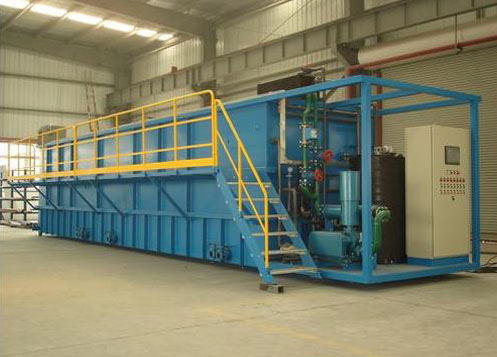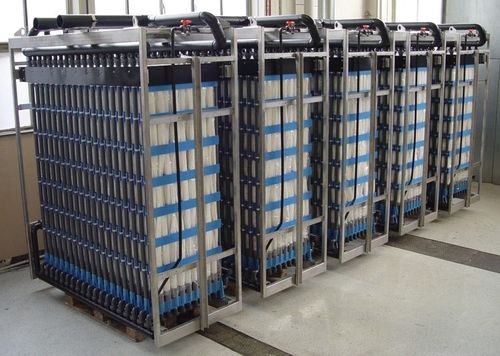Waste Water Treatment Plants
Waste Water Treatment Plants
With the dedication and commitment of our team of professionals we have emerged as one of the reliable manufacturers and exporters of modern and efficient Sewage TreatmentPlant.Designed for efficiently removing pollutants from domestic sewage,industrial and commercial waste water,the plant functions seamlessly in the treatment process.We use good component and high grade raw materials in the production of the plant.The Sewage Treatment Plant has been designed for chemical,physical and biological processes for sewage treatment so that the cleaned sewage can be disposed off safely.
Features:
- Eco friendly
- Manufactured in compliance with National standards
- Manufactured in compliance with International standards
- Optimum performance
- Requires less space for installation

More Details:
Sewage Treatment is the technique of eliminating pollutants from wastewater and household sewage as well as commercial and institutional effluents. The sewage may contain biological, physical and chemical impurities, and for removing such contaminants corresponding treatment is undertaken. The intention of sewage treatment is to release environmentally safe fluid waste stream (or treated effluent) and a solid waste (or treated sludge) ideal for harmless disposal or reuse (generally as fertilizers). With the advent of modern technology, now it is possible to re-use sewage effluent as drinking water.
SBR -Sequential Batch Reactor is an industrial processing tank for wastewater treatment. SBR reactors treat wastewater like sewage or output from mechanical biological treatment facilities or anaerobic digesters in batches. Oxygen is gurgled via the wastewater to minimize biochemical oxygen demand (BOD) and chemical oxygen demand (COD) to ensure its suitability for discharge into drainsorfor other use. The SBR is a sophisticated biological aeration type treatment plant developed to produce very high quality outputfrom the effluent.

SAFF (Submerged Aerobic Fixed Film) Waste Water Management -The submerged aerobic fixed film process (SAFF), also famous as tricking filters, comprises of specifically prepared artificial media that assist in attachment of fixed film growth of the microorganisms. The aerobic ambiance in the SAFF reactor is accomplished by making use of fine bubble diffused aeration that also works to maintain liquid in a totally mixed regime. Biological expansion on the media surface of trickling filters facilitates the transformation of suspended organic waste material into by-products such as nitrates, carbon dioxide, water and biological solids which are later eliminatedthrough cleaning process.
MBBR / FAB -Treatment of effluents having micro organisms manufactured as biofilms on biochips in an aeration tank in order to minimize the contaminant load (COD/BOD) in a Secondary Treatment process is known as Moving Bed Biofilm Technology. Owing to the provision of large surface area through biochip the micro organisms won’t come out easily from the system and they build up biofilms on the carrier element/biochip to conveniently degrade the organic material and to trim down the pollutants (COD/BOD) load. The biofilm carrier elements are kept suspended in the water by air with the help of diffusers in the aerobic reactors,and via a mixer in the reactors. The fluidized aerobic bioreactor (FAB) is developed on the concept of suspended growth along with attached growth processes. The media has certain gravity below of water. Hydraulic currents invigorated by aeration assist in fluidization of the media.
Modern Technology
Membrane Bioreactors for Wastewater Treatment
Membrane bioreactors for wastewater treatment is a combination of a suspended growth biological treatment method, usually activated sludge, with membrane filtration equipment, typically low-pressure microfiltration (MF) or ultrafiltration (UF) membranes. The membranes are used to perform the critical solid-liquid separation function. In activated sludge facilities, this is traditionally accomplished using secondary and tertiary clarifiers along with tertiary filtration. The two general types of MBR systems are vacuum (or gravity-driven) and pressure-driven systems. Vacuum or gravity systems are immersed and normally employ hollow fiber or flat sheet membranes installed in either the bioreactors or a subsequent membrane tank. Pressure driven systems are in-pipe cartridge systems located externally to the bioreactor.
An “MBR System” is considered to be a complete and integrated membrane unit (sub-systems) with related components necessary to allow the process to function as desired. An MBR system is often comprised of ten or eleven sub-systems and includes fine screening (headworks), the Membrane Zone and, in most cases, some type of post-disinfection process.
An MBR, or Membrane Zone, can best be described as the initial step in a biological process where microbes are used to degrade pollutants that are then filtered by a series of submerged membranes (or membrane elements). The individual membranes are housed in units known as modules, cassettes, or racks and a combined series of these modules are referred to as a working membrane unit. Air is introduced through integral diffusers to continually scour membrane surfaces during filtration, facilitate mixing and in some cases, to contribute oxygen to the biological process.

Owing to our years of industry experience and expertise on water treatment,filtration,and purification processes,we have emerged as one of the trusted manufacturers and exporters of advanced technology Effluent TreatmentPlant.These plants moderate the highly contaminated and polluted water released by Industries and chemical factories.The treatment plants work efficiently to remove the major impurities presenting the water and purify it for various application purposes like industrial and institutional cleaning purposes,irrigation,watering of plants and several other use fulworks.Such treatment plant offers a means to use the natural resource as recycled water.Our company provide the Effluent Treatment Plant at Industry leading prices.
Features:
- Eco friendly
- Comprehensive treatment of effluents to remove the solid impurities
- Optimum performance and functional efficiency
- Efficient model

Further Details:
We have designed the Effluent Treatment Plant to treat the effluent coming chemical industries and various types of factories. Also known as ETPs, it is used to eliminate the toxic elements present in the highly contaminated water and purify the water for various commercial and domestic applications. The plants are eco-friendly and developed for the mission of environment protection acrossthe globe. In such plants treatment of industrial effluents and wastewater is executed using latest techniques and advanced technology. The ETPS found broad application in almost every type of process industry to reduce BOD, COD, toxic elements, suspended solids & other contaminants present in the wastewater.
Primary Treatment
Primary treatment comprises elimination of pollutants by some physical methods:screens remove debris that can congest the machinery.The waste water channelized into chambers in which heavy solids like gritands and sediment at the bottom.The solids are washed prior to disposing off to sanitary landfill.It then moves to a primary settling tank where a considerable amount of the organic solids deposit at the bottom where as oils,fats,and grease float at the top.By rotating primary clarifier concurrently the primary(untreated)solids are scraped from the bottom and the grease is skimmed from the top.
Secondary Treatment
Secondary treatment generally counts on a biological process where by a huge concentration of micro-organisms assists in converting the residual organic material into other forms which can be easily split into solids and a clear liquid.In addition,Tertiary Treatment is only needed in situations where the final treated effluent should considerably clean with 95% or more of the contaminants must be eliminated by waste water treatment.Within a few hours in Tertiary treatment,the cleansing action to the tune of hundreds of miles off lowing river can be imitated with in the series of tanks.More than 95% of the impurities have been removed from the effluent and the recycled water can be disposed off into a river or stream leaving no bad environment all impacts.If treated optimally,the effluent some times is cleaner than the river water.The entire process takes less than 12 hours to complete.
Modern Technology
Membrane Bioreactors for Wastewater Treatment
Membrane bioreactors for wastewater treatment is a combination of a suspended growth biological treatment method, usually activated sludge, with membrane filtration equipment, typically low-pressure microfiltration (MF) or ultrafiltration (UF) membranes. The membranes are used to perform the critical solid-liquid separation function. In activated sludge facilities, this is traditionally accomplished using secondary and tertiary clarifiers along with tertiary filtration. The two general types of MBR systems are vacuum (or gravity-driven) and pressure-driven systems. Vacuum or gravity systems are immersed and normally employ hollow fiber or flat sheet membranes installed in either the bioreactors or a subsequent membrane tank. Pressure driven systems are in-pipe cartridge systems located externally to the bioreactor.
An “MBR System” is considered to be a complete and integrated membrane unit (sub-systems) with related components necessary to allow the process to function as desired. An MBR system is often comprised of ten or eleven sub-systems and includes fine screening (headworks), the Membrane Zone and, in most cases, some type of post-disinfection process.
An MBR, or Membrane Zone, can best be described as the initial step in a biological process where microbes are used to degrade pollutants that are then filtered by a series of submerged membranes (or membrane elements). The individual membranes are housed in units known as modules, cassettes, or racks and a combined series of these modules are referred to as a working membrane unit. Air is introduced through integral diffusers to continually scour membrane surfaces during filtration, facilitate mixing and in some cases, to contribute oxygen to the biological process.

Such type of clarifiers provides an extremely economical method to separate solids from liquids using gravitational energy.Using high grade materials and components,we manufacture it perfectly for extensive application in domestic and industrial settings.We offer Lamella Clarifier in different capacities at Industry leading prices.
Features:
- Eco friendly
- Comprehensive treatment of effluents to remove the solid impurities
- Optimum performance and functional efficiency
- Efficient model
Further Details:
Inclined tube/plate Clarifiers – Filtration process using gravity clarifier is the most economical technique of eliminating solids from liquid due to the fact that natural gravity is the originating point of energy and it is free. A clarifier basically offers a non-turbulent zone where heavier solids than liquid, dissolved by turbulence, are given sufficient time to deposit at a dormant surface. Our range of inclined tube/plate clarifiers are sturdy units with multiple layers of settling area making use of less than 25% of the floor space needed by conventional clarifiers.

These clarifiers are mainly used in the treatment of wastewater for removing sediment, turbidity and floating material present in the water. This type of clarifier comprises circular center feed and circular peripheral flow, which efficiently eliminates all kinds of dissolved solids and dispel them via the scum trough. We use high grade raw materials to manufacture Circular Clarifiers that are demanded for optimum performance with high efficiency.
Features:
- Sturdy construction
- Long functional life
- Easy maintenance
More Details:
Considered as the oldest method, clarification is the most extensively used method for the efficient treatment of wastewater. The operation comprises removing of sediment, floating and turbidity material from wastewater.trough.

The ASUL’s circular mechanical clarifiers encompasses circular center feed, and circular peripheral flow types and functions in a ways that effluent entering through a center combined well with the flow being forced downward. This makes sure the ideal hold time of the water in the clarifier to be in operation till the solids are settled. The water then rises and flows through a wall-mounted weir trough placed on the inner perimeter of the clarifier. A skimmer sweeps over the surface of the clarifier to gather any floatable solids and dispel them via the scum
